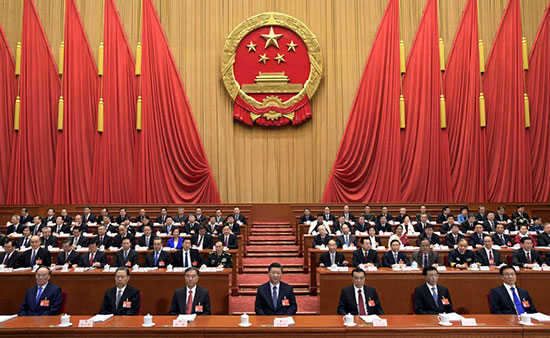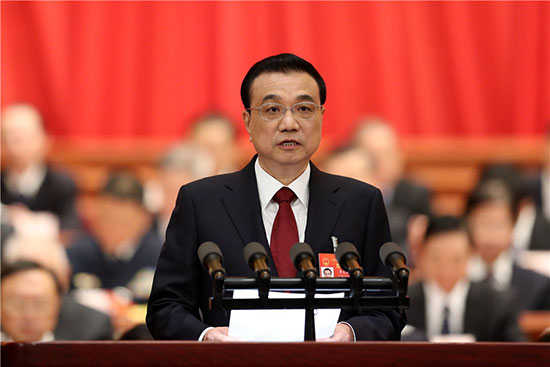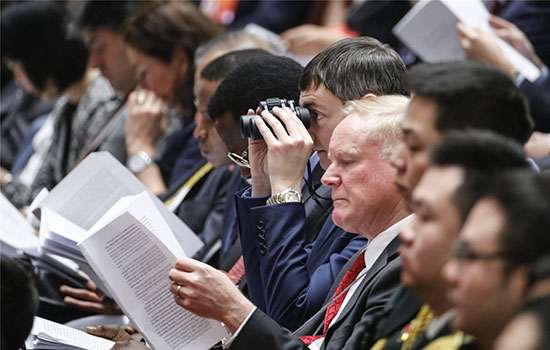

Annual Government Work Report sets GDPgrowth target for 2019 at 6-6.5%

Xi Jinping, general secretary of the Communist Party of China Central Committee, president, and chairman of the Central Military Commission, attends the opening meeting of the second session of the 13th National People’s Congress at the Great Hall of the People in Beijing on Tuesday. FENG YONGBIN / CHINA DAILY
China has lowered its annual GDP growth target for this year and plans to take a series of measures, such as reductions of taxes and fees, to shore up the economy, Premier Li Keqiang said in the Government Work Report that he delivered to legislators and political advisers on Tuesday.
The country set the target of economic growth at between 6 and 6.5 percent for 2019, Li told participants in the opening of the second session of the 13th National People's Congress. China's year-on-year GDP growth came in at 6.6 percent in 2018.
Analysts said that by adopting a target range instead of a single figure, policymakers will have more room to maneuver and carry out economic restructuring to lay a solid foundation for future sustainable growth.
"The lowered growth target reflects both domestic and external uncertainties that the Chinese economy faces," said Cheng Shi, chief economist at ICBC International. "On the other hand, it is in line with China's transition from high-rate growth to high-quality development," he said.
The growth target range is more binding than a single figure, said Zhang Ming, an economist at the Institute of World Economics and Politics of the Chinese Academy of Social Sciences. "By setting the floor of the target range at 6 percent, China is unlikely to tolerate a growth rate lower than 6 percent this year," he said.

Premier Li Keqiang delivers the annual Government Work Report. FENG YONGBIN/CHINA DAILY
Li said the country will face increasing uncertainties arising from slowing global economic growth and escalating protectionism and unilateralism, as well as domestic economic easing.
He vowed to make the proactive fiscal policy more forceful and efficient and make the prudent monetary policy neither too tight nor too loose, while prioritizing the employment policy to keep the country's economic growth "within a reasonable range".
The country plans to create 11 million new jobs this year and keep the surveyed urban unemployment rate at around 5.5 percent.
To keep the economy on track, Li said, China plans to raise its fiscal deficit to GDP ratio to 2.8 percent this year from 2.6 percent in 2018. The local special-purpose debts will total 2.15 trillion yuan ($320.78 billion) this year — 800 billion yuan more than last year.
"The fiscal deficit ratio does not reach or exceed 3 percent as widely anticipated by the market, which points to the cautiousness of the central authorities," said Zhang of CASS.
China will also cut nearly 2 trillion yuan in taxes and corporate pension payments to bolster the corporate sector, especially private and small enterprises. The value-added tax rate for the manufacturing industry will be lowered to 13 percent from 16 percent, and the rate for transportation and construction industries will be cut to 9 percent from 10 percent.
"The tax cuts exceed general market expectations, and the raised deficit ratio will provide ample room for increasing investment in infrastructure this year," said Cheng of ICBC International.

Foreign diplomats read the Government Work Report. KUANG LINHUA/CHINA DAILY
As China implements growth stabilization, restructuring and risk prevention policies, its growth is likely to fall within its set target range, he said. "The possibility is high that it will be close to the 6.5 percent cap of the range."
A stable Chinese economy will also serve as an anchor for the world economy, analysts said.
China is a major contributor to global growth and a country that helps the development of poor countries, said Khairy Tourk, an economics professor at the Stuart School of Business of the Illinois Institute of Technology in Chicago. "A growing Chinese economy is crucial to prosperity in other regions of the world, especially in Asia and Africa," he told Xinhua News Agency.
In the Government Work Report, China set its target for consumer inflation growth at 3 percent for this year, while it will try to keep growth of the broad measure of money supply, or M2, largely at the same level as last year.
 Fire brigade in Shanghai holds group wedding
Fire brigade in Shanghai holds group wedding Tourists enjoy ice sculptures in Datan Town, north China
Tourists enjoy ice sculptures in Datan Town, north China Sunset scenery of Dayan Pagoda in Xi'an
Sunset scenery of Dayan Pagoda in Xi'an Tourists have fun at scenic spot in Nanlong Town, NW China
Tourists have fun at scenic spot in Nanlong Town, NW China Harbin attracts tourists by making best use of ice in winter
Harbin attracts tourists by making best use of ice in winter In pics: FIS Alpine Ski Women's World Cup Slalom
In pics: FIS Alpine Ski Women's World Cup Slalom Black-necked cranes rest at reservoir in Lhunzhub County, Lhasa
Black-necked cranes rest at reservoir in Lhunzhub County, Lhasa China's FAST telescope will be available to foreign scientists in April
China's FAST telescope will be available to foreign scientists in April "She power" plays indispensable role in poverty alleviation
"She power" plays indispensable role in poverty alleviation Top 10 world news events of People's Daily in 2020
Top 10 world news events of People's Daily in 2020 Top 10 China news events of People's Daily in 2020
Top 10 China news events of People's Daily in 2020 Top 10 media buzzwords of 2020
Top 10 media buzzwords of 2020 Year-ender:10 major tourism stories of 2020
Year-ender:10 major tourism stories of 2020 No interference in Venezuelan issues
No interference in Venezuelan issues
 Biz prepares for trade spat
Biz prepares for trade spat
 Broadcasting Continent
Broadcasting Continent Australia wins Chinese CEOs as US loses
Australia wins Chinese CEOs as US loses